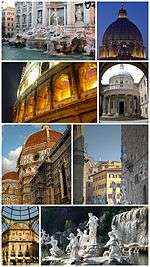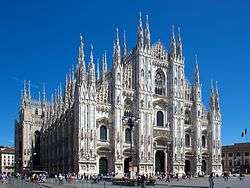Italian Gothic architecture
| Architecture of Italy |
|---|
 |
| Periods and styles |
| Palaces and gardens |
| Notable works |
| Notable architects |
|
|
| By region |
|
| Other topics |

.jpg)
Gothic architecture appeared in Italy in the 12th century. The architectural ardite solutions and technical innovations of the French Gothic cathedrals never appeared: Italian architects preferred to keep the construction tradition established in the previous centuries. Aesthetically, in Italy the vertical development was rarely important.
A possible timeline of Gothic architecture in Italy can comprise:
- an initial development of the Cistercian architecture
- an "early Gothic" phase (c. 1228-1290)
- the "mature Gothic" of 1290-1385
- a late Gothic phase from 1385 to the 16th century, with the completion of the great Gothic edifices begun previously, as the Milan Cathedral and San Petronio Basilica in Bologna.
Beginnings of Gothic architecture in Italy
Gothic architecture was imported into Italy, just as it was in many other European countries. The Benedictine Cistercian order was, through their new edifices, the main carrier of this new architectural style. It spread from Burgundy (in what is now eastern France), their original area, over the rest of Western Europe.
This kind of architecture had in fact already included most of the novelties which characterized the Gothic cathedrals of Île-de-France, but with a more subdued, and somewhat "ascetic", formal approach. Figurative decorations are banned. The stained glass windows are reduced in size and colorless. The verticalism is reduced. In the exterior bell towers and belfries are absent.
Always present, however, are oval rectangular groin vaults and clustered piers, composed by an ensemble of smaller columns, which continue with engaged pillars to the vaulting-ribs. The capitals have very simple decorations, usually not figurative. The stone-dressing is very accurate as well. The result is a quasi-modern cleanness, lacking embellishments.
The Cistercian architecture could be easily adapted, with slight modifications, to the necessities of Mendicant Orders such as the Dominicans and the Franciscans, which at the time were expanding rapidly throughout Italy. Both strove for a certain cleanness, when not poverty, in their edifices. They needed large naves and aisles to allow the faithful to follow the sermon and rites without visual obstacles, as often happened in cathedrals, whose interiors contained numerous pilasters and had the choir separated by walls from the nave.
12th century
As previously stressed, the first Italian Gothic edifices were Cistercian abbeys. They spread throughout Italian territory, often adapting construction techniques to local traditions. There were in fact brickwork edifices in the Pianura Padana, while stone prevailed in central Italy and Tuscany. In the latter was sometimes present the by-chrome wall decoration from the local Romanesque tradition.
The most important edifices include the Chiaravalle Abbey in northern Italy and the Casamari Abbey in central Italy. Among the non-Cistercian buildings of this century which were influenced by the Gothic style, though still presenting important Romanesque features, are the Parma Baptistery by Benedetto Antelami and the church of Sant'Andrea in Vercelli, also featuring Antelami's influences.
13th century
This century saw the construction of numerous Gothic buildings for the Mendicant Orders. The most important ones include:
- Basilica of San Francesco of Assisi (1228–1253)
- Church of Santa Maria della Spina, Pisa (1230)
- Basilica of Sant'Antonio of Padua
- Church of San Francesco, Bologna (1236–1263)
- Church of Santa Maria Novella, Florence
Also notable is the civil and military construction program promoted by Emperor and King of Sicily Frederick II of Hohenstaufen in southern Italy at the beginning of the century. The most important works promoted by him include:
- Castel del Monte, in Apulia
- Castel Maniace, in Syracuse, Sicily
- Triumphal Gate in Capua (destroyed)
In this period some cathedrals were also constructed or finished, such as Siena Cathedral.
14th century
Around the late 13th century several important Gothic or Gothic-like edifices were begun, which were to be completed in the following century. These include;
- Basilica of Santa Croce, Florence
- Cathedral of Santa Maria del Fiore, Florence
- Palazzo Vecchio, Florence
- Basilica di Santa Maria Gloriosa dei Frari, Venice
- Orvieto Cathedral
In the late 14th century two major Italian late-Gothic edifices were begun, the Duomo di Milano and the Basilica di San Petronio at Bologna.
15th century
In the 15th century no new major Gothic edifices were built in Italy, while the construction of large basilicas and cathedrals begun continued. In particular, the realization of Filippo Brunelleschi
See also
References
- This article is a translation of the corresponding Italian Wikipedia article.
